hypermesh与flac接口
abaqus与hypermesh接口教程
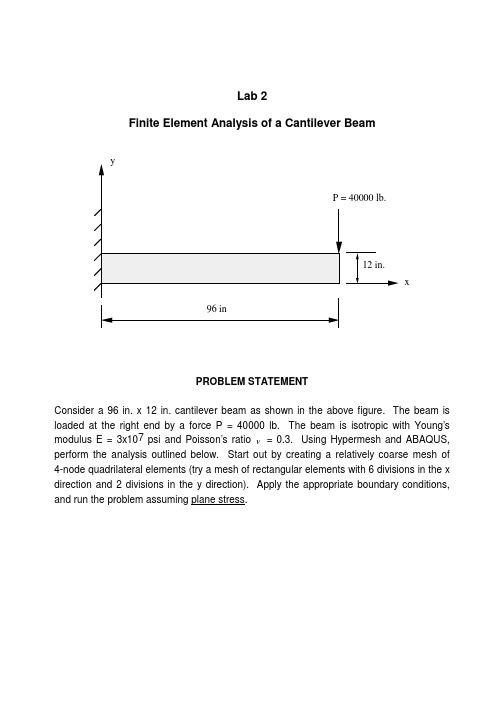
Consider a 96 in. x 12 in. cantilever beam as shown in the above figure. The beam is loaded at the right end by a force P = 40000 lb. The beam is isotropic with Young’s modulus E = 3x107psi and Poisson’s ratio ν= 0.3. Using Hypermesh and ABAQUS, perform the analysis outlined below. Start out by creating a relatively coarse mesh of 4-node quadrilateral elements (try a mesh of rectangular elements with 6 divisions in the x direction and 2 divisions in the y direction). Apply the appropriate boundary conditions, and run the problem assuming plane stress.Instructions for Lab#2Using Hypermesh and ABAQUS for the analysis of a beam in bending.Figure 1. Main Window in Hypermesh. Circled is the command toolbar that allows the user to access sub menus.Getting Acquainted1) Fire up Hypermesh from the menu controls.2) Familiarize yourself with the command toolbar to your right. By clicking next to eachtitle as circled above, you will be brought to several sub-menus where you may perform a variety of tasks. Click on each and analyze each sub-menu.3) Identify commands that appear self-explanatory, such as file, automesh, nodes,lines, ect....4) Notice that the file command exists in every toolbar.5) Click on the file command. This is where you name the hypermesh files you wouldlike to save using a *.hm extension. Also, this is where importing and exporting occurs.6) Also notice the template command. This is where the solvers are invoked.Hypermesh has the capability of exporting mesh information for a variety of solvers.Keep in mind, Hypermesh is purely a mesh generator and the mesh information must be translated into the format of the desired solver to be used, therefore picking the correct solver from the template is a necessary step before continuing with any other stepsGeometryIn this exercise we will generate the geometry of a beam to be deformed by applying a tip point load and by fixing one end. After completion of the geometry generation, a 3-dimensional mesh of the beam will be created and a stress analysis on the beam will be performed.1) Like all mesh generators, in order to create a mesh, some geometry must exist.Generally nodes are required from which lines are created. Surfaces must be created from a set of lines that form a closed loop. It is those surfaces that will be meshed.2) Click on the “Geom” icon to your right and notice the various menus. In particular,notice the “nodes” icon. Clicking on that will allow to create several nodes in a variety of modes. For example, by co-ordinates (most popular one), on lines, ect..3) Once the nodes exist, one can create lines from those nodes by clicking on the“line” button. Note the options available for the different type of lines that can be created. Go ahead and create lines from the existing nodes.4) With the lines created, surfaces can be generated by clicking on the “surface edit”button and by selecting the filler surface option. Create a surface using all existing lines.5) At this point the geometry has been created and mesh generation should be thenext step.Mesh generationIn this phase of the exercise the geometry created above will be meshed. The first step will be to mesh the two-dimensional surface with 2-D elements. Two meshes will be generated, a biased mesh and regular mesh. Samples can be seen in the figures below. When that is done, the two meshes will be extruded to create the three-dimensional brick element meshes.Figure 2. A simple quad mesh with no biasing.Figure 3. A biased quad mesh focused toward one end.Creating a 2-D mesh.1) With all surfaces created, it is time to mesh.2) Prior to creating elements, the concept of “collectors” must be reviewed.Hypermesh has the ability to store groups of elements under different names called collectors. In this manner, it is possible to modify parts of a mesh on a group basis.We will practice using these collectors to store the two meshes that will be generated for the same part. In one collector we will store the elements for the mesh in figure 2 and in another collector we will store the mesh for figure 3. To create collectors, click on the “collectors” button and create the two collectors using two different names and two different colors.3) You can toggle between the two collectors by using the “global button” in the righthand bottom corner and selecting the collector you wish to work in. It is important that you know which collector is being used as default and changing it will be necessary as the meshing progresses. Further you may display the desired collectors by using the “display” command in the bottom right corner and by clicking and un-clicking on each collector that is available. With that done we may proceed to create the two meshes.4) Make sure you know which collector is currently set to default. To begin meshing,click on the 2D toolbar to your right.5) There are a variety of options available. We will use the automesh option.6) By clicking on automesh, several parameters are required as well as the necessityto select the surfaces one wants to mesh.7) Select the surface by clicking on each and supply a rough idea of the element sizeand element type you would like to use. Also make sure you are in the interactive mode.8) Once that is done, clicking the mesh button will generate a tentative idea of howyour mesh will look along the geometry borders. You may enhance your mesh by improving on the coarseness, adding bias, ect... By clicking on the number of divisions for each line you may increase that value using the left button or decrease that value using the right button. Similar things can be done if one wants to change the bias or other parameters.9) With that done, clicking on the mesh button will create the mesh. Accept the meshby clicking return or reject it by clicking reject.10) T he above steps must be repeated to create a biased mesh toward the fixedlocation. To do that repeat steps 3-8, but ensuring yourself that you are in the appropriate collector. Also, when the tentative divisions on the border of your surface appear, you can add bias by clicking on the bias button and giving positive or negative bias values.Note: Your part may consist of several surfaces and you may mesh them all at once or separately. You may also allocate each meshed portion to different collectors, so as to be able to have control over your model based on the different portions meshed.Creating a 3-D mesh.1) The next step involves extruding the mesh from its 2-D version, thus creating a 3-Dmesh.2) The first step is two create two additional collectors into which the two 3-D mesheswill be saved.3) With that done, click on the “3D” button and click on the drag button.4) The drag button allows the user to drag a set of 2-dimensional elements into 3-dimensional elements so long that a drag direction and distance are supplied, as well as the intended number of divisions to be created on the way.5) Select the elements to be dragged by component and define a drag direction anddistance. Supply the intended number of divisions. With that done, click on the drag button. Your 3-dimensional mesh will be created within the chosen collector.6) Do the same for the second 2-dimensional mesh and ensure that it is put in theappropriate collector.7) With that done, it will be necessary to delete the unnecessary 2-dimensionalmeshes. To do so press the F2 key and delete elements by component and select the two components to be deleted. Click on “delete” to approve deletion of the two selected components.Boundary conditionsOnce the mesh has been created, it is necessary to create the required boundary conditions. Boundary conditions can be created within Hypermesh for use in ABAQUS, however the complexity of the steps within Hypermesh, outweighs the ease of typing in boundary conditions within the ABAQUS file, provided that the appropriate node sets and element sets are available. This is what will be done in the next steps.1) We need two sets. A node sets for those nodes that will be fixed and a node set forthose nodes onto which the load will be applied.2) To do so, click on the BCs menu. There you will create entity sets. Entity sets issimply a manner to groups nodes or elements under one common name. In ABAQUS, boundary conditions can be applied to those sets.3) Click on entity sets and create a node set called “fixed”. Select the nodes on the leftend of the beam by using the window select. When done click on create. If the set is created, click on RESET.4) Change the name to “load” and select the nodes onto which the load will be appliedand click on create.5) This will be it!With the mesh completed you may now export your file using the ABAQUS template and saving the file under a *.inp extension. You can do this by clicking on file and then selecting the export command. MAKE SURE YOU ARE USING THE “ABAQUS STANDARD” TEMPLATE. Be careful here!NOTE: Remember you have two meshes on top of each other. Before you export each mesh as *.inp file, you must create to separate Hypermesh files. In each file save only the mesh you desire. This is done by deleting the unwanted mesh and saving under a different name. Deleting elements or nodes is accomplished using the F2 command. It is also a good idea to go ahead and renumber your mesh when you are ready to finalize it. Renumbering is accomplished by clicking on the tools icon and then clicking on the renumber button. Do this for each mesh. Now we are ready for ABAQUS.IN ABAQUSThe general ABAQUS file follows your typical format for any FEA solver. It contains nodal information and connectivity as well as element type information. At the end are the boundary conditions and the solution procedure. This can be observed below.Open the *.inp file that was created. It should look as follows:**** ABAQUS Input Deck Generated by HyperMesh Version3.0**** Template: ABAQUS/STANDARD***** THIS IS THE NODAL INFORMATION*NODE1, 0.0 , 2.221825 , -7.778174: : :: : :: : :9843, 6.7033386359838, 3.648821000031 , 0.0539689803571*** THIS IS THE ELEMENT INFORMATION. C3D8= 8 noded brick element.*ELEMENT,TYPE=C3D8,ELSET= threeD1, 1858, 1857, 1878, 1879, ………….: : :: : :: : :8470, 478, 522, 9807, 9774, ……….** SECTION DEFINITION: assign material and thickness if necessary for shells.*SOLID SECTION, ELSET= threeD, MATERIAL= ALUMINUM*** HERE ARE THE ENTITY SETS TO BE USED FOR THE B.C.’s*NSET, NSET= fixed1, 2, 3, 4, 5, 6, 7, 8,9, 10, 11, 12, 13, 14, 15, 16,*NSET, NSET= load448, 449, 450, 451, 452, 453, 454, 455,**** MATERIAL PROPERTIES*MATERIAL, NAME= MAT1*ELASTIC, TYPE = ISOTROPIC10000000.0,0.22,0.0********THIS IS WHAT YOU ADD MANUALLY LOAD STEP INFORMATION, BOUNDARY CONDITION INFORMATION, AND OUTPUT INFORMATION.******STEP*STATIC --- TYPE OF ANALYSYS*CLOAD --- TYPE OF LOADload,1,-1.0*BOUNDARY --- TYPE OF DISPLACEMENT BCfixed,1,3,0.0*EL FILE --- ELEMENT OUTPUT TO BE VIEWED IN HYPERMESHSINV*NODE FILE --- NODAL OUTPUT TO BE VIEWED IN HYPERMESHU*EL PRINT, ELSET=threeD --- ELEMENT OUTPUT TO BE LISTED IN DATA FILES11,S22,S33,S12,S13,S23E11,E22,E33,E12,E13,E23*NODE PRINT, NSET=fixed --- NODAL OUTPUT TO BE LISTED IN DATA FILEU,RF*END STEPWith this in mind, you should modify your file to include necessary analysis information and boundary conditions. When that is done, you can run your two ABAQUS filesVIEWING THE RESULTS IN HYPERMESH.Once the ABAQUS run is complete, you need to convert the *.fil into a hypermesh *.res file. Do this by using the hmabaqus command within your unix template. Now open Hypermesh.1) Retrieve one of the models and click on the global button.2) You will see a path for the results file. Enter the filename assigned above.3) Exit this menu and click on the POST icon and view your results by using thecontour button.Some contour plots of a beam in bending. You may create displacement contours, stress contours, ect…Figure 4. The displacement contour plot for a beam in bending.Figure 5. Von-Mises Stress Contour for a beam in bending.General Tips:1) When meshing a model in separate portions it is necessary to create a collector foreach portion and making sure one has selected the correct collector before meshing a surface so that those elements created are fed into the desired collector2) Also, one must always check for duplicate elements or nodes. This can be donewith appropriate commands in the tools toolbar available at your right. We will explore these commands in class.。
hypermesh常见问题汇总
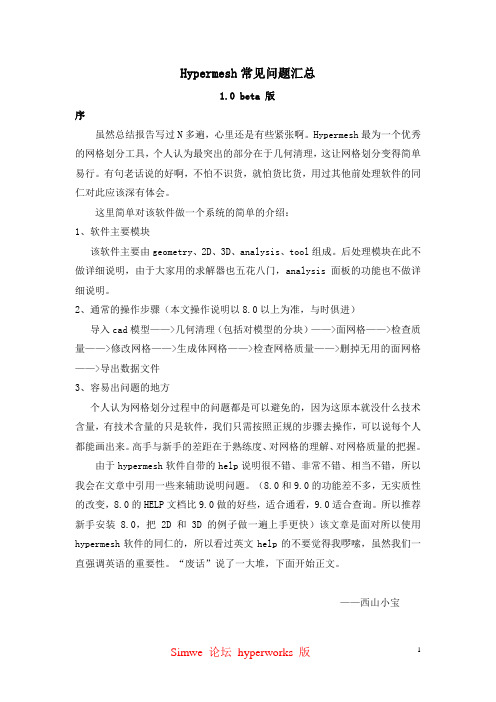
——hg_boy
关于hypermesh的单位
跟大多数有限元软件一样,hm只认数值,不认单位的。
( t I! t. h; `单位只有使用者本人知道。
9 E* V& O0 V& n5 o- M你只要保证各个量所使用的单位的一致性就可以了。
find edge主要用来检查面网格模型是否封闭,为生成体网格作准备。如果一个面网格模型不存在free edge和T connect. 就能判定这个网格是一个封闭的面网格。
——flyingwings
正常情况下find edge后只在边界部位生成edge,如果在其他地方生成了edge,说明该处有缝隙,网格不连续。Find face 同理。(可参考 HELP:Tofindthe freeedgesin a group of elements)
8、3 S- J8 v# S; ?/ I5 J线长度
& u F$ i& a; ?( m; n3 W8 N; T检查杆系网格线的长度。
9、9 B; X" X! @5 E. S7 Y! g* u+ k3 \二维面网格两边交角.
检查面网格的两个边构成的角度。
——civil fans
如何快捷删除重合面
8.0GEOM->SURFACE->FIND DUPLICATES
3、容易出问题的地方
个人认为网格划分过程中的问题都是可以避免的,因为这原本就没什么技术含量,有技术含量的只是软件,我们只需按照正规的步骤去操作,可以说每个人都能画出来。高手与新手的差距在于熟练度、对网格的理解、对网格质量的把握。
hypermesh使用指南

Hypermesh软件是美国Altair公司的产品,是世界领先的、功能强大的CAE应用软件包,也是一个创新、开放的企业级CAE平台,它集成了设计与分析所需的各种工具,具有无与伦比的性能以及高度的开放性、灵活性和友好的用户界面。
FEA流程图:Step1:CAD模型的导入与修复文件导入文件的导入有很多种方式,常用的是导入parasolid形式,即x_t 文件。
因为这种文件不容易出现缝隙、重叠、边界错误等缺陷,减轻了几何清理的工作量。
File→import→Geometry→parasolid→**.x_t(导入的模型如果是组件,最好直接将组件导入,在HM中组装比较麻烦。
)几何清理如图,geom页面点击autocleanup,使用线框模型来查看模型。
线条为红色是自由边,表示相邻曲面没有相互连接,或者相邻曲面间有空隙。
线条为黄色为T形连接边,表示曲面的边界被三个或三个以上的曲面所共享,如果不是,说明模型存在重复曲面。
修补方法:(1)缝补破面。
Geom页面选择surfaces面板,点击左上方Spline/Filler选项,不选Keep Tangency选项。
对象设置为lines,激活Auto Create(Free Edges only)选项,点击破损平面的一条边。
(2)删除所有重复面。
在Geometry菜单中点击Defeature→Duplicates →Surfaces→Displayed。
在Cleanup Tol中输入0.01,点击find→Delete。
Step2:几何模型的简化简化几何模型是指为了使零件几何形状更简单而去掉一些细节。
根据分析问题的需要,比如考虑零件在总装配中的重要程度、几何特征与分析问题的着重点的相关程度、几何特征尺寸与平均网格尺寸的对比等因素,模型的某些几何细节(如一些小孔或倒角)可以忽略。
删除对于分析没有必要的模型细节,有助于改善网格质量,分析也会进行得更有效率。
进入页面Geometry→DefeaturePinholes选项:删除小孔。
基于HYPERMESH复杂地质体的FLAC3D实体建模
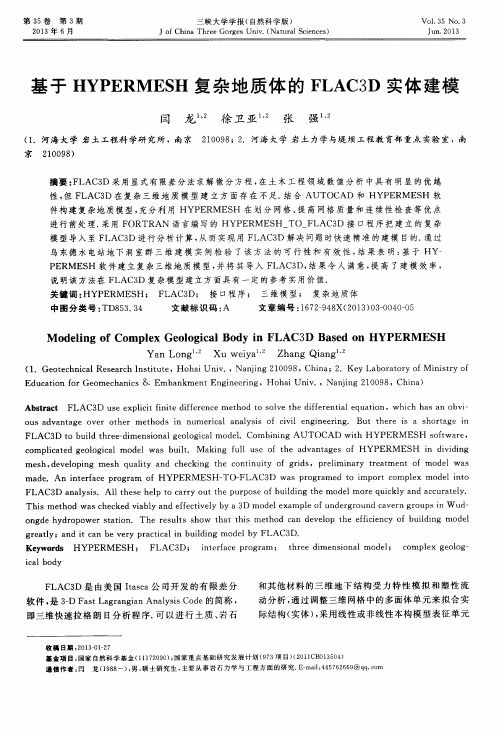
第五章HyperMesh的求解器接口和模板介绍
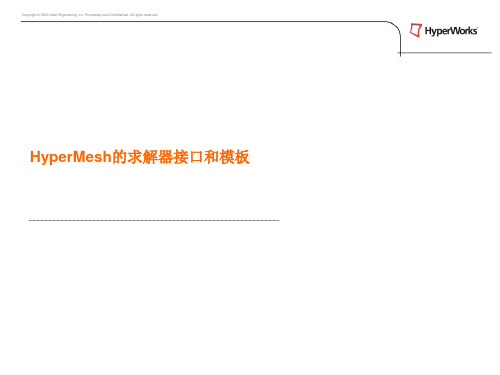
Copyright © 2009 Altair Engineering, Inc. Proprietary and Confidential. All rights reserved.
练习:从卡片中自动获取数据
• • 在OptirStruct模板中获取ID号为1的MAT1类型的材料的Young’s Modulus (E), Shear Modulus (G), Poisson’s ratio (Nu), 和 density (Rho) 显示获得的这些值
求解器的卡片
• OptiStruct MAT1类型材料的卡片示例:
• 上图中每一个输入项都对应了optistruct模型中的一个属性和数据名,这个模型 在:
<altair_home>/templates/feoutput/common_nas_os/attribs
• 其中的一部分定义如下:
*defineattribute(E,1,real,none) *defineattribute(G,2,real,none) *defineattribute(Nu,3,real,none) *defineattribute(Rho,4,real,none)
• 当我们创建一个新的名称为steel MAT1类型的材料时,command.cmf文件记 录下的HyperMesh的命令:
*collectorcreate(materials,"steel","",11) *createmark(materials,2) "steel" *dictionaryload(materials,2,"C:/Altair/hw10.0/templates/feo utput/optistruct/optistruct","MAT1") *attributeupdateint(materials,1,3240,1,2,0,1) *attributeupdatedouble(materials,1,1,1,1,0,210000) *attributeupdatedouble(materials,1,2,1,0,0,0) *attributeupdatedouble(materials,1,3,1,1,0,0.3) *attributeupdatedouble(materials,1,4,1,1,0,7.85e-009) *attributeupdatedouble(materials,1,5,1,0,0,0) *attributeupdatedouble(materials,1,6,1,0,0,0) *attributeupdatedouble(materials,1,7,1,0,0,0) *attributeupdatedouble(materials,1,341,1,0,0,0) *attributeupdatedouble(materials,1,343,1,0,0,0) *attributeupdatedouble(materials,1,345,1,0,0,0) *attributeupdateint(materials,1,5237,1,2,0,0)
Hypermesh与其它有限元软件的接口及单位

Hypermesh与其它有限元软件的接口及单位(轉)一:单位:1.默认:tonne,mm,s, N, MPa单位系统,这个单位系统是最常用,还不易出错(吨,mm 和s)备注:长度:m;力:N;质量:kg;时间:s;应力:Pa;密度:kg/m3长度:mm;力:N;质量:吨;时间:s;应力:MPa;密度:吨/m m 32.Hypermesh公英制设置:1)永久菜单里的option。
2)8.0里面可以自定义设置:control card-->DTI_UNIT中可以设置。
二:hypermesh与其他软件的几何接口问题汇总(一)Autocad建立的模型能导入hypermesh:因为autocad的三维建模功能不是很强,一般不建议在autocad里面进行建模。
如果已经在autocad里面建好模型的话,在autocad里面存贮成*.dxf的格式就可以导入到hypermesh里面。
(二)catia的装配件导入hm:转为step格式或者是iges格式。
(三)UG.NX3版本导入Hypermesh7.0。
用igs格式可以,但是igs容易丢失信息。
一般都是把NX3的prt文件导成catia格式的model 文件,然后import到hypermesh中,stp的效果还可以(四)在hm画好的网格能导入patran继续划分:用Nastran求解,确实在patran做前处理比较方便,先存为bdf文件,一点信息都不会丢。
hypermesh 和patran 都是前处理器,只要存成某一个求解器的文件格式(如nastran的dat/bdf 文件),都可以打开的。
(五)hm划的网格导入fluent:在hypermesh中输出bdf格式,用fluent导入即可。
(六)在hypermesh里划分的网格导到marc:在hypermesh中输出dat格式.准备只用hypermesh分网,这样comp的card image、material是否要设?user profile设成哪个?是nastran吗?comp的card image、material可以不设的,这些工作可以在marc做,user profile设成hypermesh就可以了!(七) HM剖分的网格导入Patran在HYPERMESH中完成网格划分后,将模型导入到PATRAN进行边界条件、载荷的设定。
hypermesh与其他软件的借口及单位(HyperMesh and other software excuses and units)
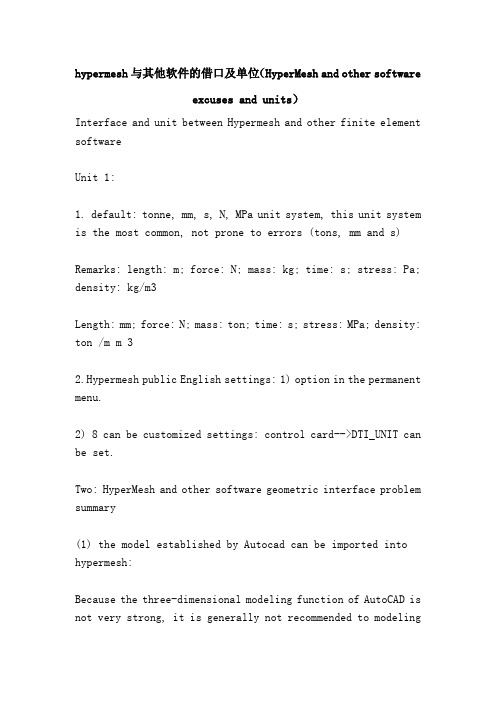
hypermesh与其他软件的借口及单位(HyperMesh and other softwareexcuses and units)Interface and unit between Hypermesh and other finite element softwareUnit 1:1. default: tonne, mm, s, N, MPa unit system, this unit system is the most common, not prone to errors (tons, mm and s)Remarks: length: m; force: N; mass: kg; time: s; stress: Pa; density: kg/m3Length: mm; force: N; mass: ton; time: s; stress: MPa; density: ton /m m 32.Hypermesh public English settings: 1) option in the permanent menu.2) 8 can be customized settings: control card-->DTI_UNIT can be set.Two: HyperMesh and other software geometric interface problem summary(1) the model established by Autocad can be imported into hypermesh:Because the three-dimensional modeling function of AutoCAD is not very strong, it is generally not recommended to modelingin autocad. If the model has been built in AutoCAD, stored in AutoCAD as a *.dxf format, you can import into the HyperMesh inside.(two) assembly of CATIA into hm:Convert to step format or IGES format.(three) import UG.NX3 version into Hypermesh7.0.IGS format can be, but IGS is easy to lose information. PRT file is generally NX3 into the CATIA format of the model file, and then import to HyperMesh, STP effect can also be(four) in the grid drawn by HM, Patran can be imported and continued to be divided:Using Nastran to solve, it is more convenient to do pre processing in Patran, first saved as BDF file, a little information will not be lost.Both HyperMesh and Patran are preprocessor, which can be opened as long as the file format of a Solver (such as the NASTRAN file of dat/bdf).(five) HM meshes into fluent:Output BDF format in HyperMesh, import with fluent.(six) the mesh in HyperMesh is guided to marc:Output dat format in HyperMeshReady to use HyperMesh only, so comp image, material and card should be set? What is the setting of user profile? Is it NASTRAN? Comp's card, image, material can not be set, these work can be done in Marc, user profile set to HyperMesh on it!(seven) mesh generation of HM subdivision into PatranAfter the grid division is completed in HYPERMESH, the model is imported into PATRAN to set the boundary conditions and loads. But after import, it is found that only grid has no entity. How can grid and entity be embedded into it?The boundary conditions can be added to the grid. If you want geometry, you can export geometry from HyperMesh, import it in Patran, but that's only geometry. Or directly import geometry that was originally imported into HyperMesh, and the geometry and mesh associated with the Patran in associate can add boundary conditions and loads on geometry(eight) Hypermesh pre-processing data into Nastran solution method:The method of importing the pre-processing data of Hm into Nastran, taking static analysis of a simple structure as an example.1. first, the HM must be set as a model of the natran template exampleTwoThis is a two dimensional static problem,The unit selects CQUAD4 and CTRIA3 and sets it in element types;Property is PSHELL,Material MAT1,The shell thickness is selected by 10, and hm8.0 can be set in the component;The constraint is SPC and the load is FORCE.3. after setting the grid all boundary conditions, it is necessary to set the subcase according to the NASTRAN card and select the load and constraint in the subcase. When you create subcase, select Edit, which will let you select the output request. Are consistent with the NASTRAN control section of the working condition4. in control there are some common cards we need to set, such as SOL/PARAM/TITLE/SET and so on. It is worth mentioning that if you want to directly use hyperview post-processing, you need to choose post=-1. in PARAM, so that op2 files can be directly formed. There are also commonly used autospc, coupmass, k6rot, maxratio and so on in param5. output dat or BDF file, can be submitted to the NASTRAN solution, and then use the op2 file with hyperviewpost-processing software after post-processing, static analysis process is probably so. But remember, no matter what pre-processing software, must be familiar with the NASTRAN card, so as to learn to use the powerful function of nastran.Note: because Nastran does not have its own interface, the constraints and loads must be applied in the HM, except for the grid. And it's very convenient! Personally think HV is better than HM.(nine) interface between HyperMesh and ansys:In HM, file--export--template, and then write the filename.Inp in outputIf you want to save CDB, the file name.Cdb is ok.The A:HY model is leading to ANSYS1. must call the ANSYS tamplate template in HM2. in the 1D 2D 3D most of the lower corner of the elem type inside re refresh the unit type, must be refreshed!!3. pay attention to remember that there are several components of the model, how many ID numbers are each, and each ID corresponds to the unit type,4. in ANSYS preprocessor/element/add edit delete inside add unit type, must be in the element type reference number after filling the corresponding HM ID number, and then select thecorresponding unit typeAll 5. are defined. Then open the model under file/read input from!In addition, it is better to save from HM to InP format, so that the success rate will be higher. (in HM, file--export--template, and then write the filename.Inp after output. If you want to save CDB, the file name.Cdb is OK)Another method:1. export select ANSYS.tpl template, in HyperMesh, export file to *.prp;2. and then open it with a clipboard and edit it:(1) delete the sentences that define unit type, material, real constant, retain only the statements of generating nodes and units, and delete (TYPE, MAT, REAL, etc.)(2) add the unit type, material, real constant sentence that you want to define.* this actually takes advantage of nodes and cell information in HM.(3) in ANSYS, the INPUT *.prp file is ok.Or:1) export select ANSYS.tpl template,In HyperMesh, the export file is file.cbd, file.iges;2) open ANSYS, write commands cdread, DB, file, CBD3) enjoy yourself.B: related issues1.hm8.0 export to ANSYS problem:To manually define the unit type and update it, you can only guide the node. But the template of HyperMesh 7 can be exported without setting, and the template should be set in 8 A little different from 7, defining the unit type elem typeWhy import the grid from HyperMesh to ANSYS, and only nodes have no units?2. lead to ANSYS, only node has no unit problemWhen using the file menu in read ANSYS input file from...... The function, and then prompts that element type XX is not defined? And then there's no unit, just a node Solving measures:1. first use the HyperMesh function of export to export the.Inp file required by ansys,2. and then edit the InP file, before defining the keyword of the unit, and add the followingET, A, XXXXB, XXXXET, C, XXXXNote: A/B/C is the code that indicates which units are not defined, and XXXX represents the unit type in ansys. Such as PLANE42, solid185 and so on, is to first declare to ANSYS, type A is plane42, type B is solid185...And then save this InP, and then re import ANSYS can be used.Example:In HM, select the Ansys template, export as a text file (suffix name arbitrary) modify the text file: addN, 497125, 58, 0.5,8.66666666666666N,497126, 58.0, 8.8817841970e - 16, 8.66666666666666N, 497127, 58.0, 1.5, 9.83333333333333N, 497128, 58.0, 2.0, 9.83333333333333修改type后的类型为hm中定义的类型如:Type, solid185 $Mat, $3, 4ESYS, 0In 594486, 518789, 518776, 518772, 518772, 519397, 519384, 519380, 519380In 594487, 518772, 518776, 518778, 518778, 519380, 519384, 519386, 519386In 594488, 518792, 518779, 518798, 518798, 519400, 519387, 519406, 5194063. 在hm里施加的载荷, 导入ansys里不见了具体操作: 在hm里生成3d网格, 施加约束和载荷, 删除3d网格以外的所有集合 (2d和实体), 这时看见所加约束和载荷都在, 但是导入ansys后就不见了, 还提示2d导入错误, 把2d都删掉了, 哪来的2d?在ansys里plotctrl下的设置显示边界条件, 再plot.。
hypermesh入门篇(转)心得
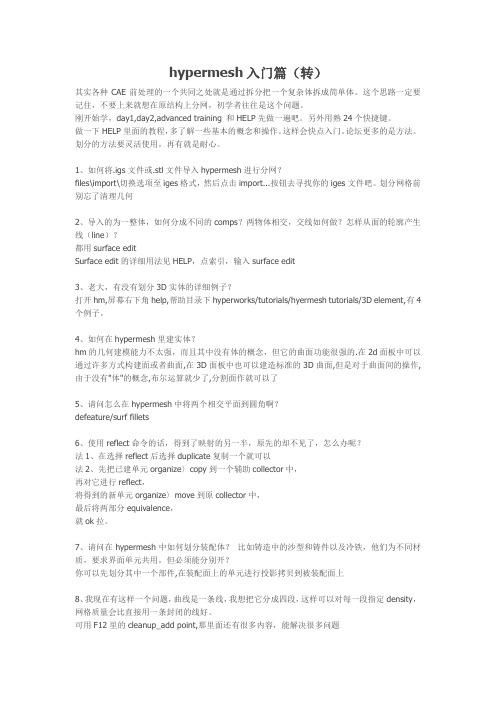
hypermesh入门篇(转)其实各种CAE前处理的一个共同之处就是通过拆分把一个复杂体拆成简单体。
这个思路一定要记住,不要上来就想在原结构上分网,初学者往往是这个问题。
刚开始学,day1,day2,advanced training 和HELP先做一遍吧。
另外用熟24个快捷键。
做一下HELP里面的教程,多了解一些基本的概念和操作。
这样会快点入门。
论坛更多的是方法。
划分的方法要灵活使用,再有就是耐心。
1、如何将.igs文件或.stl文件导入hypermesh进行分网?files\import\切换选项至iges格式,然后点击import...按钮去寻找你的iges文件吧。
划分网格前别忘了清理几何2、导入的为一整体,如何分成不同的comps?两物体相交,交线如何做?怎样从面的轮廓产生线(line)?都用surface editSurface edit的详细用法见HELP,点索引,输入surface edit3、老大,有没有划分3D实体的详细例子?打开hm,屏幕右下角help,帮助目录下hyperworks/tutorials/hyermesh tutorials/3D element,有4个例子。
4、如何在hypermesh里建实体?hm的几何建模能力不太强,而且其中没有体的概念,但它的曲面功能很强的.在2d面板中可以通过许多方式构建面或者曲面,在3D面板中也可以建造标准的3D曲面,但是对于曲面间的操作,由于没有"体"的概念,布尔运算就少了,分割面作就可以了5、请问怎么在hypermesh中将两个相交平面到圆角啊?defeature/surf fillets6、使用reflect命令的话,得到了映射的另一半,原先的却不见了,怎么办呢?法1、在选择reflect后选择duplicate复制一个就可以法2、先把已建单元organize〉copy到一个辅助collector中,再对它进行reflect,将得到的新单元organize〉move到原collector中,最后将两部分equivalence,就ok拉。
hypermesh论坛常见问题汇总
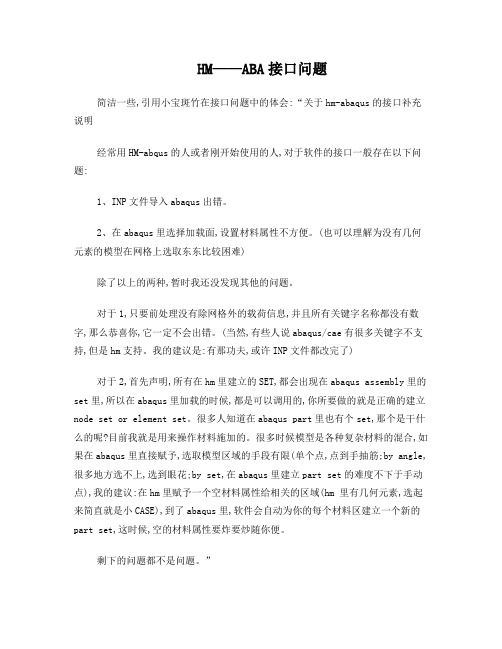
HM——ABA接口问题简洁一些,引用小宝斑竹在接口问题中的体会:“关于hm-abaqus的接口补充说明经常用HM-abqus的人或者刚开始使用的人,对于软件的接口一般存在以下问题:1、INP文件导入abaqus出错。
2、在abaqus里选择加载面,设置材料属性不方便。
(也可以理解为没有几何元素的模型在网格上选取东东比较困难)除了以上的两种,暂时我还没发现其他的问题。
对于1,只要前处理没有除网格外的载荷信息,并且所有关键字名称都没有数字,那么恭喜你,它一定不会出错。
(当然,有些人说abaqus/cae有很多关键字不支持,但是hm支持。
我的建议是:有那功夫,或许INP文件都改完了)对于2,首先声明,所有在hm里建立的SET,都会出现在abaqus assembly里的set里,所以在abaqus里加载的时候,都是可以调用的,你所要做的就是正确的建立node set or element set。
很多人知道在abaqus part里也有个set,那个是干什么的呢?目前我就是用来操作材料施加的。
很多时候模型是各种复杂材料的混合,如果在abaqus里直接赋予,选取模型区域的手段有限(单个点,点到手抽筋;by angle,很多地方选不上,选到眼花;by set,在abaqus里建立part set的难度不下于手动点),我的建议:在hm里赋予一个空材料属性给相关的区域(hm 里有几何元素,选起来简直就是小CASE),到了abaqus里,软件会自动为你的每个材料区建立一个新的part set,这时候,空的材料属性要炸要炒随你便。
剩下的问题都不是问题。
”论坛问题汇总1、hypermesh导入abaqus有单元显示、无模型显示。
答:这个问题很常见,不仅在hypermesh_to_abaqus中有人问,在HM与其它软件接口也有人反复问。
首先要肯定的是导入过程没有任何问题。
在此,引用老向版主的一段话来回答“版上不停的有人问为什么HM不能导出几何.看的人都烦了.为什么要导出几何呢?* H_m C?@不同的软件,对几何的理解是不一样的, 所以才有这么多的不同的几何格式.E0H x8?0m5 D k如果要导出几何,HM还得去研究你abaqus/ansys/patran内部是如何理解几何的,这是个浩大的工程.M S0M你应该知道,对于求解器来说,它只需要知道节点,单元,材料,载荷等信息就能够求解了.要几何干什么呢?X q3w G A6 H8A5d几何模型的作用仅仅是为了得到节点,网格.. 一旦有节点,网格有了,几何模型就可以扔掉了.* $c3 E&~C6x4n V#R2后处理程序本身也是基于有限元模型的,而不是基于几何模型的.D6K6C?798g你既然打算用HM做前处理,就干脆一点,把所有的东西都在HM里面做好,然后提交给abaqus/nastran计算就行了.p49W u9XHM对abaqus求解器的支持一点不比abaqus/cad本身差,只有及少数特殊的场合,需要手工添加一些语句.”2、从HM中把一个装配件划分好的网格生成inp文件后,导入abaqus中去,为什么是一个零件,怎样才能是一个装配件?答:part, instance是abaqus独有的概念。
Hypermesh与LS-DYNA 接口练习
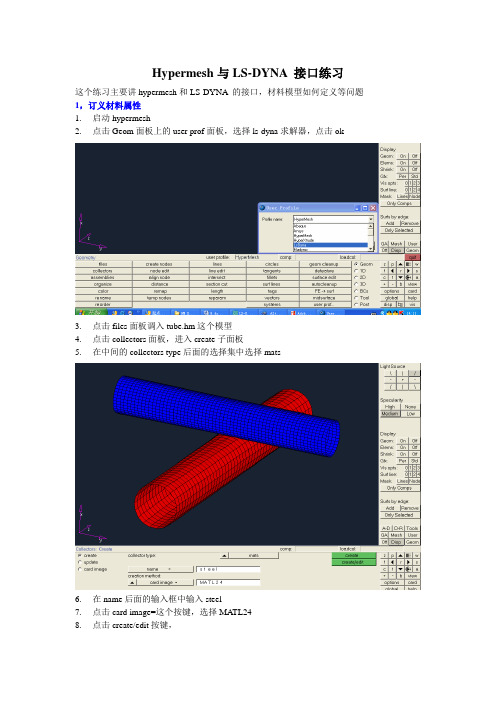
Hypermesh与LS-DYNA 接口练习这个练习主要讲hypermesh和LS-DYNA 的接口,材料模型如何定义等问题1,订义材料属性1.启动hypermesh2.点击Geom面板上的user prof面板,选择ls-dyna求解器,点击ok3.点击files面板调入tube.hm这个模型4.点击collectors面板,进入create子面板5.在中间的collectors type后面的选择集中选择mats6.在name后面的输入框中输入steel7.点击card image=这个按键,选择MA TL248.点击create/edit按键,9.点击RHO,在下面的输入框中输入7.8e-6(不知道有什么用,什么意思)10.点击E,在下面的输入框中输入21011.点击NU在下面的输入框中输入0.3(不知道有什么用,什么意思)12.点击SIGY ,在下面的输入框中输入0.2(不知道有什么用,什么意思)13.点击return,返回到collectors面板2定义单元属性1,进入create子面板,在collectors type后面的选择集中选择props2,在name=后面的输入框中输入section1.53,点击card method 下面的选择集,选择card image=4,点击card image=按键选择Sect Shll5,点击material=按键,点击steel6,点击create/edit7,点击T1,在下面的输入框中输入1.58,点击return,返回collectors面板3,更新模型1,进入update子面板2,在collectors右面的选择集中选择comps3,点击黄色的comp按键,选择出现的这两个comp4,点击select按键5,点击material按键,选择steel6,点击update7,选择material id8,点击update4,更新单元的截面属性1,进入card image子面板2,在collector type右面的选择集中选择comp 3,点击name=按键,选择fixed tube4,点击card image=按键,选择part5,点击load/edit按键6,点击SID,出现一个黄色的按键7,点击这个黄色的按键,选择section1.58,点击return,更新完毕9,重复一遍刚才的过程,为moving tube更新截面属性5,订义边界条件1,点击BCs面板上的entity set2,在name=后面的输入框中输入nodes for velocity 3,在中间的选择集中选择nodes4,点击这个黄色的nodes按键,选择by collector5,选择moving tube,点击select在屏幕上出现选择的节点6,点击create7,点击collector面板8,进入create子面板9,在collector type右面的选择集中选择loadcal10,在name=后面的输入框中输入ini_vel11,点击card image按键选择InitialVel(不知道有什么用,什么意思)11,点击create/edit12,点击[NSID]出现一个黄色的按键,点击这个黄色的按键,就出现两个选择集点击刚刚创建的nodes for velocity13,点击vx(不知道有什么用,什么意思),在下面对输入框中输入30,点击return,返回面板13,在name=后面的输入框中输入spc,点击card image=选择BoundSPCset点击create/edit14,点击[NSID],出现一个黄色的按键,点击这个按键,选择nodes for spc 15,约束6 个自由度6,定义接触1,点击BCs页面下的set_segment,,在name=后面的输入框中输入master2,点击card image=选择segment,3,点击黄色的elems按键,点击by collector,点击fixed tube,点击select 4,选择一个颜色,点击create,结果如下5,同理,在定义一个名为slave的segment6,退出这个面板,点击interface面板,进入create子面板7,在name=后面输入contact8,点击下面的type=键,选择SurfaceToSurface9,点击下面的card image=,也选择SurfaceToSurface,点击create/edit,10,在下面的option下的选择集中,选择automatic11,进入add子面板,在master下面的选择集中选择csurfs,点击旁边的contactsurf按键,选择master点击select,点击右面的update同理在slave下面的选择集中也选择csurfs,点击旁边的contactsurf按键,选择slave,点击点击select,点击右面的update。
HyperMesh与ANSYS接口培训教程
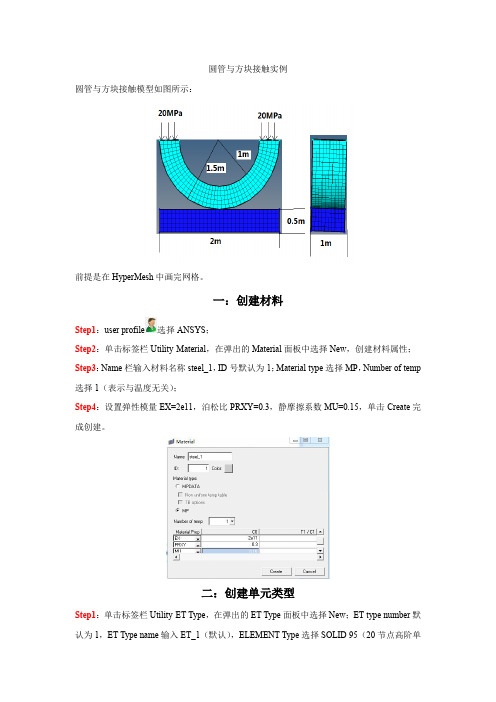
圆管与方块接触实例圆管与方块接触模型如图所示:前提是在HyperMesh中画完网格。
一:创建材料Step1:user profile选择ANSYS;Step2:单击标签栏Utility-Material,在弹出的Material面板中选择New,创建材料属性;Step3:Name栏输入材料名称steel_1,ID号默认为1;Material type选择MP,Number of temp 选择1(表示与温度无关);Step4:设置弹性模量EX=2e11,泊松比PRXY=0.3,静摩擦系数MU=0.15,单击Create完成创建。
二:创建单元类型Step1:单击标签栏Utility-ET Type,在弹出的ET Type面板中选择New;ET type number默认为1,ET Type name输入ET_1(默认),ELEMENT Type选择SOLID 95(20节点高阶单元);Step2:注意SOLID 95为20节点二阶单元,而HyperMesh中画的网格为一阶单元,因此执行:工具栏Mesh-Assign-Element Order,在弹出的面板中选择change to 2nd,选择所有单元,并点击编办右侧的change order。
三:将材料以及单元类型赋给相应的单元Step1:单击标签栏Utility-Component Manager,在弹出的界面中,鼠标左键点击TUBE,Assign Values选择Mat Set No.以及1-steel_1,单击set完成TUBE下所有单元的材料赋值;Step2:Assign Values选择ET Ref. No.以及1-(ET_1)SOLID95,单击set完成TUBE下所有单元的单元类型的赋值;Step3:重复step1以及step2,给BLOCK赋材料以及单元类型。
注:Remarks栏中不出现错误提示,才表明赋值成功。
四:创建接触Step1:单击标签栏Utility-Contact Manager;在弹出的Create New Contact Pair界面中,Contact Type选择3D(体-体接触),其他保持默认;单击Pick Tatget选择接触面;Step2:component 选择TUBE并点击proceed,在弹出的Target Elements Selection中,双击Elements黄色按钮,此时在TUBE集合下自动创建了红色的表面单元;Step3:选择如下图所示的单元作为目标单元,并单击右侧的proceed;为降低计算时间,最好选择接触区域附近的表面单元。
基于HyperWorks的典型接头优化设计
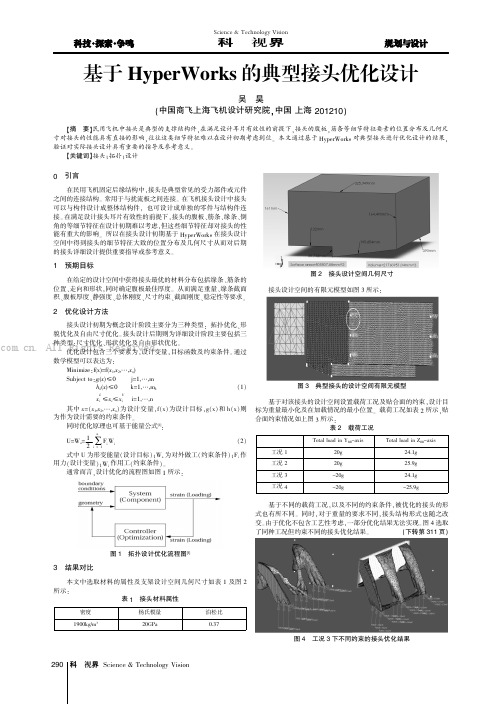
通常而言,设计优化的流程图如图1所示:图1拓扑设计优化流程图[1]结果对比本文中选取材料的属性及支架设计空间几何尺寸如表表1接头材料属性图2接头设计空间几何尺寸接头设计空间的有限元模型如图3所示:图3典型接头的设计空间有限元模型基于对该接头的设计空间设置载荷工况及贴合面的约束,设计目标为重量最小化及在加载情况的最小位置。
载荷工况如表2所示合面约束情况如上图3所示:表2载荷工况基于不同的载荷工况,以及不同的约束条件,被优化的接头的形式也有所不同。
同时,对于重量的要求不同,接头结构形式也随之改由于优化不包含工艺性考虑,一部分优化结果无法实现。
图4选取了同种工况但约束不同的接头优化结果。
(下转第311页)图4工况3下不同约束的接头优化结果密度杨氏模量泊松比1900kg/m320GPa0.37Total load in Y RB-axis Total load in Z RB-axis 工况120g24.1g工况220g25.9g工况3-20g24.1g工况4-20g-25.9g(上接第157页)制,来进一步提高成本控制效果,在保证工程质量及工期前提下,最大程度实现经济利益最大化,促进我国公路建造事业的可持续发展。
【参考文献】【参考文献】[1]王勇.电力调度的安全管理及电能质量控制措施[J].中国新技术新产品,2014(21):131.[2]孙逊.电力调度过程中的安全控制探讨[J].中国新技术新产品,2014(23):114.[3]蒋娟.电力调度与电网安全运行[J].电子世界,2013(14):25-26.[4]谢晓琳.论新形势下电力调度的安全管理[J].通信电源技术,2012(6):108-109.(上接第290页)图5工况3下迭代优化过程中最大位移与接头质量对比图4结论本文通过上述有限元模型及拓扑计算对典型接头进行了优化设的接头优化设计结果再进行深度迭代计算优化可对后。
图2医院设备采购廉洁风险防控平台总体架构图通过平台的建设来完成医院。
hypermesh与flac接口
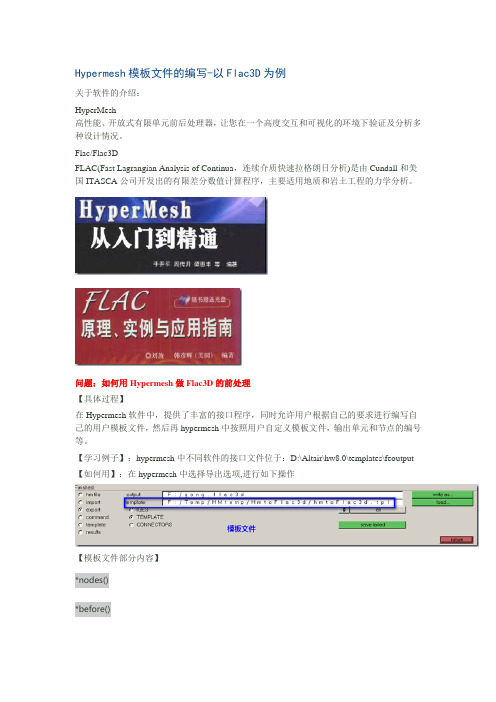
Hypermesh模板文件的编写-以Flac3D为例关于软件的介绍:HyperMesh高性能、开放式有限单元前后处理器,让您在一个高度交互和可视化的环境下验证及分析多种设计情况。
Flac/Flac3DFLAC(Fast Lagrangian Analysis of Continua,连续介质快速拉格朗日分析)是由Cundall和美国ITASCA公司开发出的有限差分数值计算程序,主要适用地质和岩土工程的力学分析。
问题:如何用Hypermesh做Flac3D的前处理【具体过程】在Hypermesh软件中,提供了丰富的接口程序,同时允许用户根据自己的要求进行编写自己的用户模板文件,然后再hypermesh中按照用户自定义模板文件,输出单元和节点的编号等。
【学习例子】:hypermesh中不同软件的接口文件位于:D:\Altair\hw8.0\templates\feoutput【如何用】:在hypermesh中选择导出选项,进行如下操作【模板文件部分内容】*nodes()*before()*string("G ")*fieldleft(integer,id,16)*string(" ")*fieldleft(real,x,16)……*fieldright(real,z,16)*end()*after()*output()*elements(204,0,"Tetra4","property")*before()*beforecollector()*string(";;ELEMENTS GROUP = ")*fieldleft(string,,8) *end() *format()*string("Z T4 ")*fieldleft(integer,id,8)……*fieldleft(integer,node4.id,32) *end()*aftercollector()*after()*output()导出的效果:。
Hypermesh资料-图文
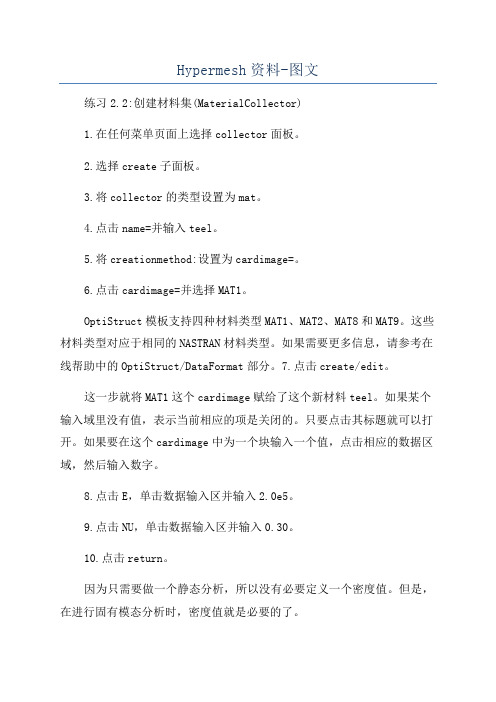
Hypermesh资料-图文练习2.2:创建材料集(MaterialCollector)1.在任何菜单页面上选择collector面板。
2.选择create子面板。
3.将collector的类型设置为mat。
4.点击name=并输入teel。
5.将creationmethod:设置为cardimage=。
6.点击cardimage=并选择MAT1。
OptiStruct模板支持四种材料类型MAT1、MAT2、MAT8和MAT9。
这些材料类型对应于相同的NASTRAN材料类型。
如果需要更多信息,请参考在线帮助中的OptiStruct/DataFormat部分。
7.点击create/edit。
这一步就将MAT1这个cardimage赋给了这个新材料teel。
如果某个输入域里没有值,表示当前相应的项是关闭的。
只要点击其标题就可以打开。
如果要在这个cardimage中为一个块输入一个值,点击相应的数据区域,然后输入数字。
8.点击E,单击数据输入区并输入2.0e5。
9.点击NU,单击数据输入区并输入0.30。
10.点击return。
因为只需要做一个静态分析,所以没有必要定义一个密度值。
但是,在进行固有模态分析时,密度值就是必要的了。
这些二维单元被用来构造这个管状模型的实体单元。
2.点击name=并输入hell_elem。
5.点击color并从互动菜单中选择一个颜色。
1.点击name=并输入olid_elem。
2.将creationmethod:设置为cardimage=。
3.点击cardimage=并从弹出菜单中选择PSOLID。
4.点击material=并选择teel。
5.点击color并从弹出菜单中选择一个颜色。
6.点击create来创建这个collector。
因为在PSOLID这个card中没有可以编辑的输入区域,就不用使用create/edit选项了。
7.点击return退出collector面板。
Hypermesh和Abaqus的接口分析实例
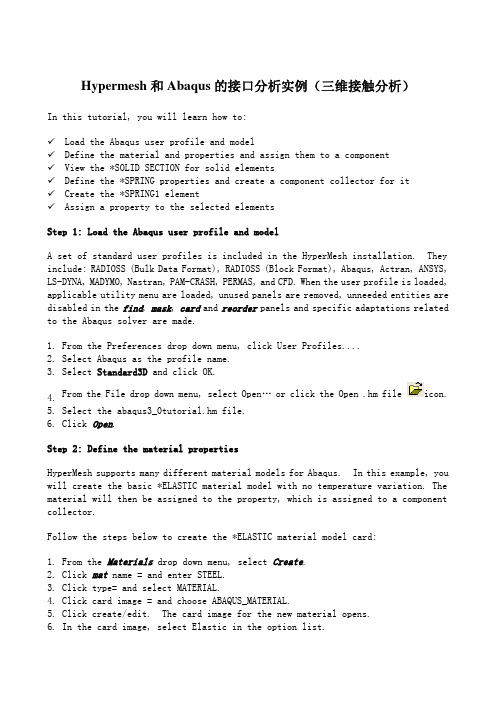
Hypermesh和Abaqus的接口分析实例(三维接触分析)In this tutorial, you will learn how to:✓Load the Abaqus user profile and model✓Define the material and properties and assign them to a component✓View the *SOLID SECTION for solid elements✓Define the *SPRING properties and create a component collector for it✓Create the *SPRING1 element✓Assign a property to the selected elementsStep 1: Load the Abaqus user profile and modelA set of standard user profiles is included in the HyperMesh installation. They include: RADIOSS (Bulk Data Format), RADIOSS (Block Format), Abaqus, Actran, ANSYS, LS-DYNA, MADYMO, Nastran, PAM-CRASH, PERMAS, and CFD. When the user profile is loaded, applicable utility menu are loaded, unused panels are removed, unneeded entities are disabled in the find, mask, card and reorder panels and specific adaptations related to the Abaqus solver are made.1. From the Preferences drop down menu, click User Profiles....2. Select Abaqus as the profile name.3. Select Standard3D and click OK.4. From the File drop down menu, select Open… or click the Open .hm file icon.5. Select the abaqus3_0tutorial.hm file.6. Click Open.Step 2: Define the material propertiesHyperMesh supports many different material models for Abaqus. In this example, you will create the basic *ELASTIC material model with no temperature variation. The material will then be assigned to the property, which is assigned to a component collector.Follow the steps below to create the *ELASTIC material model card:1. From the Materials drop down menu, select Create.2. Click mat name = and enter STEEL.3. Click type= and select MATERIAL.4. Click card image = and choose ABAQUS_MATERIAL.5. Click create/edit. The card image for the new material opens.6. In the card image, select Elastic in the option list.7. By default, the selected type is ISOTROPIC. If not, click the switch and select ISOTROPIC.8. By default, the ELASTICDATACARDS= field value is 1. If not, input 1 to set thenumber of datalines.9. Click the field beneath E(1) and enter 2.1E5.10.Click the field beneath NU(1) and enter 0.3.11.Click return to accept the changes to the card image.12.Click return to exit the panel.Step 3: Define the *SOLID SECTION properties1. From the Properties drop down menu, select Create.2. Click prop name= and enter Solid_Prop.3. Choose a color for the property.4. Click on type=and set it to SOLID SECTION. This ensures that sections pertaining only to solid elements are available as card image options. Alternatively, the type = field can be set to ALL ensuring that all available card images are listed.5. Click on card image= and select SOLIDSECTION.6. Click material= and select STEEL.7. Click create.8. Click return to exit the panel.Step 4: Assign the property to the componentBecause the material is assigned to the property, when you assign the property to a component, the material is automatically assigned as well.1.From the Collectors drop down menu, select Edit and select Components.2.Click the yellow comps button and select INDENTOR and BEAM from the list.3.Click select.4. If necessary, click the toggle to switch <property blank> to property= .5. Double-click property= and select the Solid_Prop.Notice that the card image= and material= are already set from the Solid_Prop property.6. Click update.7. Click return to exit the panel.Step 5: View the *SOLID SECTION for solid elementsHyperMesh supports sectional properties for all elements from the property collector.Complete the steps below to view the *SOLID SECTION card for an existing component:1. From the Properties drop down menu, select Card Edit.2. Click props and select Solid_Prop from the list of property collectors.3. Click select to finish the selection process.4. Click edit to view the *SOLID SECTION property card image.5. Click return to finish the viewing process.6. Click return to exit the panel.Step 6: Define the *SPRING propertiesIn Abaqus contact problems, it is common to use weakly grounded springs to provide stability to the solution in the first loading step. This section explains how to create these springs and how to create the *SPRING card.Complete the steps below to create the *SPRING card:1. From the Properties drop down menu, select Create.2. Click prop name= and type in Spring_Prop.3. Choose a color for the property collector.4. Click on type=and set it to LINE SECTION. This ensures that sections pertaining only to 1D elements are available as card image options. Alternatively, the type = field can be set to ALL ensuring that all available card images are listed.5. Click on card image= and select SPRING.6. Click material= and select STEEL.7. Click create/edit.8. In the dof1 field, enter 3.The dof2 field in the *SPRING card is ignored by Abaqus for SPRING1 elements.9. In the Stiffness field, enter 1.0E-5.10.Click return to accept the changes to the card image.11.Click return to exit the panel.Step 7: Create a component collector for the *SPRING property1. From the Collectors drop down menu, select Create and select Components.2. Click comp name= and type in GROUNDED.3. Choose a color for the property collector.4. If necessary, click the toggle to switch <property blank> to property= .5. Double-click property= and select the Spring_Prop.Notice that the card image = and material = are already set from the Spring_Prop property.6. Click create.7. Click return to exit the panel.To reset the view for further processing:1. Click the isometric view icon .Step 8: Create the SPRING1 element1. From the Mesh drop down menu, select Assign and select Element Type.2. In the 1D sub-panel, click mass = and select SPRING1.In HyperMesh, grounded elements are created and stored as mass elements since they only have one node in the element connectivity.3. Click return to exit the panel.4. On the status bar at the bottom of the window, the name of the current component is displayed. Click on that name.5. Select GROUNDED from the list of component collectors that appears.As the spring elements are created, they will be placed in this component.6. From the Mesh drop down menu, select Create and select Masses.7. Click nodes and select by id from the pop-up menu.8. In the id = field, enter 451t460b3 and click Enter on the keyboard.This shorthand selects all of the nodes from 451 to 460 in increments of 3.9. Click create.10.Click return to exit the panel.定义接触面和相互作用Step 9: Start the Contact Manager1. From the Utility menu, click the Contact Manager button.The Abaqus Contact Manager dialog opens.Step 10: Create the "Indentor-top" surface1. Select the Surface tab in the Abaqus Contact Manager dialog.2. Click the New… button.The Create New Surface dialog opens.3. In the Name: field, enter indentor-top.4. Select Element based as the type of surface.5. Click Color and select a color.6. Click Create….The Element Based Surface dialog opens for defining elements and corresponding faces for the surface.7. In the Model Browser, expand the Components folder to display all the contents. Right-click on indentor and select Isolate.8. Click the user views icon and select top.9. In the Element Based Surface dialog, select the Define tab.10.In the Define surface for: list, select 3D solid, gasket.11.Click the Elements button.This opens the element selector panel.12.Click the elems button.13.Select by collector.14.Check the indentor component and click select.You will see the elements in indentor component highlighted.15.Click proceed to return to the Element Based Surface dialog.16.Select Solid skin option from the Select faces by: radio buttons.17.Select a color from the Solid skin color: button.18.Click the Faces button.This creates a temporary skin of the selected elements and opens the element selector panel.19.Select an element from the top of the solid skin.20.Click the elems button and select by face.You will see all faces at the top of the solid skin are highlighted.21.Rotate the model in HyperMesh interface to verify all desired faces are selected.You can deselect any element (by right clicking) or add more if you like.22.When you are satisfied with the element faces selected, click proceed to return to the Element Based Surface dialog.23.Click the Add button to add these faces to the current surface.This creates special "face" elements (rectangles with dot in the middle) for display.You can reject the recently added "faces" by clicking the Reject button. You can also delete "faces" from the Delete Face page.24.When satisfied with the surface definition, click Close to return to the AbaqusContact Manager dialog.Step 11: Create the "Beam-bot" surface1. Select the Surface tab in the Abaqus Contact Manager dialog and click the Display None button to undisplay all surfaces.2. Click the New… button.This opens the Create New Surface dialog.3. In the Name: field, enter cylinder-top.4. Select Element based as the type of surface.5. Click the Color: button and select a color.6. Click Create….The Element Based Surface dialog opens for defining elements and corresponding faces for the surface.7. In the Model Browser, expand the Components folder to display all the contents. Right-click on Beam and select Isolate.8. In the Element Based Surface dialog, select the Define tab.9. In the Define surface for: list, select 3D solid, gasket.10.Click the Elements button.This opens the element selector panel.11.Click the elems button, select by collector, check Beam component and click select. This highlights the elements in Beam component.12.Click proceed to return to the Element Based Surface dialog.13.Select Solid skin from the Select faces by: radio buttons.14.Select a color from the Solid skin color: button.15.Click the Faces button.This creates a temporary skin of the selected elements and opens the element selector panel.16.Select an element from the solid skin, click the elems button, and select by face.You will see faces all around the solid skin are highlighted.17.Rotate the model in the HyperMesh interface to verify all desired faces are selected.You can deselect any element (by right clicking) or add more if you like.18.When you are satisfied with the element faces selected, click proceed to returnto the Element Based Surface dialog.19.Click the Add button to add these faces to the current surface.This creates special "face" elements (rectangles with dot at the middle) for display.You can reject the recently added "faces" by clicking the Reject button. You can also delete "faces" from the Delete Face page.20.When satisfied with the surface definition, click Close to return to the Abaqus Contact Manager dialog.Step 12: Define the surface interaction propertyIn this exercise, you will define the *SURFACE INTERACTION card with corresponding *FRICTION card.Complete the steps below to create the "friction1" surface interaction:1. Select the Surface Interaction tab at the Abaqus Contact Manager dialog.2. Click the New… button.This opens the Create New Surface Interaction dialog.3. In the Name: field, enter friction1.4. Click the Create… button.The Surface Interaction dialog opens.5. Select the Define tab.6. Select Friction option as surface interaction property.That makes the Friction tab active.7. Select the Friction tab.8. Select the Friction type: as Default and click the Direct option.Selecting this option means that the exponential decay and Anisotropic parameters will not be written to the input file.9. In the No of data lines field, enter 1 and click set.A single row appears in the Direct table.10.Click the first cell on the Friction Coeff column and enter 0.05. For Direct and Anisotropic tables:•The column numbers in the table will change with the No of Dependencies selected. The row numbers can be defined at the No of data lines entry box. Clicking the corresponding Set button will update the table to have the specified number of rows.•For placing values in the table, click a cell to make it active and type in the values. The table works like a regular spreadsheet.•You can also read comma-delimited data from a text file by clicking the Read From a File button. This button opens up a file browser window. Select the file and click Open to export the comma-delimited data. The row number will be set to the number of data lines found in the file.•Right-clicking in the table shows a pull down menu with copy, cut and paste options. Comma-separated data can be copied/cut into or pasted from clipboard with these options. Relevant hot keys (for example, Ctrl-c, Ctrl-x and Ctrl-v in Windows) will also work.•Clicking the left mouse button in a cell activates that cell. Clicking into an already active cell moves the insertion cursor to the character nearest the mouse.•Moving the mouse while the left mouse button is pressed highlights a selected area.•The left, right, up and down arrows moves the active cell.•Shift-<arrow> extends the selection in that direction.•Ctrl-left arrow and Ctrl –right arrow move the insertion cursor within the cell.•Ctrl -slash selects all the cells.•Back space deletes the character before the insertion cursor in the active cell. If multiple cells are selected, Back space deletes all selected cells.•Delete deletes the character after the insertion cursor in the active cell. If multiple cells are selected, Delete deletes all selected cells.•Ctrl -a moves the insertion cursor to the beginning of the active cell. Ctrl-e moves the insertion cursor to the end of the active cell.•Ctrl –minus (-) and Ctrl –equal (=) decrease and increase the width of the column with the active cell in it.•To interactively resize a row or column, move the mouse over the border while Button-1 or Button-3 (the right button on Windows) is pressed.11.Click OK to return to the Abaqus Contact Manager dialog.Step 13: Create the "Beam-Indentor" contact pair1. Go to the Interface tab of the Abaqus Contact Manager dialog.2. Click the New… button.This opens the Create New Interface dialog.3. In the Name: field, enter Beam-indentor.4. Select Contact pair as the type of interface.5. Click the Create… button.The Contact Pair window opens.6. Select the Define tab.7. Click the Surface: pull down menu to show a list of the existing surfaces.8. Select indentor from the list and click the Slave>> button to identify it as theslave surface and move it into the table.9. Click the corresponding Review button.The selected surface is highlighted in red. If the surface is defined with sets (display option disabled), the underlying elements are highlighted. Right-click on Review to clear the highlighting.The corresponding New button opens the Create New Surface dialog for creating a new surface. When you are done creating and defining the surface, the Contact Pair window returns with the new surface selected as the slave surface.10.Repeat steps 7 and 8, selecting Beam and clicking the Master>>button to identify it as the master surface.Note: To more clearly see the surfaces available for selection, click the icon.This opens an enhanced browser where you can easily search for the appropriate item. You can also click the Filter button to filter the items displayed.11.Click the Interaction: drop down list to see a list of the existing surfaceinteractions.Note: To more clearly see the interactions available for selection, click theicon. This opens an enhanced browser where you can easily search for the appropriate item. You can also click the Filter button to filter the items displayed.12.Select friction1from the list as the interaction property for the current contactpair.13.Select the Parameter tab.14.Select SmallSliding from the available options.15.Click OK to return to the Abaqus Contact Manager dialog.16 Click close to the Abaqus Contact Manager dialog.创建载荷和边界条件Step 14: Define a *STEP card and specify *STATIC as the analysis procedureIn this exercise, you will create a *STEP card with the *STATIC analysis procedure.1. On the Utility tab, click Step Manager.The Step Manager dialog is displayed.2. Click New…3. In the Name: text box enter step1.4. Click Create to create the step.This creates a step called step1 and opens the Load Step edit dialog.5. From the tree on the left side of the window, select Title.The Step heading: option with a disabled field is displayed.6. Activate the Step heading: check box and enter 100kN load in the text box.7. Click Update to store the heading information into step1.8. From the tree, select Parameter.9. Activate the Name and Perturbation check boxes, and click Update. Notice that name is already set to step1.10.From the tree, select Analysis procedure.11.For Analysis type:, select static and click Update.In this exercise, you created a step (*STEP) called step1 and specified *STATIC as the analysis procedure.12.To add a dataline, go to the Dataline tab and enable Optional dataline.13.To add individual data, such as Initial increment, enable the appropriate field and enter a value. If one entry field is not enabled, a space will be added in the ASCII file, and the Abaqus solver uses the default value.Next, you will define the loads and boundary conditions. Step 15: Create constraints (*BOUNDARY)1. From the tree, select Boundary.2. Click New… and enter loads_and_constraints in the Name: text box.3. Click Create to create the load collector.4. Optionally, click the button in the Display column and select a color for the load collector.5. Make sure the Status check box for loads_and_constraints is checked. By selecting this check box, you are adding this load collector into the loadstep.6. Click the loads_and_constraints load collector in the table.A set of new tabs is displayed on the right.7. From the Define tab, keep Type: set to default (disp).8. Click the Define from ‘Constraints’ panel button.This takes you to the Constraints panel in HyperMesh. Use this panel to create constraints.Step 16: Create constraints from the Constraints panel1. On the toolbar, click the user views icon and select right.2. Click the yellow nodes button and select by sets.3. select ENDS then Click select buttom.4. Activate dof1, dof2, dof3, unactivate dof4, dof5, dof6.5. Click create.HyperMesh creates constraints at the nodes you selected.6. Click return.You are returned to the Step Manager Load Step dialog.7. Look at the Load type: line at the bottom of the Step Manager dialog. Notice thatBc (short for BOUNDARY) appears on this line, identifying it as a load type created in the load_and_constraints load collector. The corresponding load type on the tree is also highlighted.Step 17: Create Forces (*CLOAD)1. From the tree, double-click Concentrated loads.2. Select CLOAD-Force from the expanded options under Concentrated loads.3. Click New… and enter 100KN_loaded in the Name: text box.4. Click Create to create the load collector.5. Optionally, click the button in the Display column and select a color for the load collector.6. Make sure the Status check box for 100KN_loaded is checked. By selecting this checkbox, you are adding this load collector into the loadstep.7. Click the 100KN_loaded load collector in the table.A new set of tabs is displayed.8. From the Define tab, define CLOAD_Force on: Nodes or geometry.9. From Define tab, click Define from ‘Forces’ Panel.The HyperMesh Forces panel is displayed. Use this panel to create forces. Step 18: Create forces from the Forces panel1. From the graphics area, click the central node on the front side of the indentor.2. In the magnitude: text box, enter –100 kN.3. Click the switch next to N1, N2, N3 and select Y-axis.4. Click create.5. Click return.You are returned to the Step Manager Load Step dialog.6. Notice that Cload-f is now added to the Load type: line, indicating CLOAD-force as another load type created in the loads_and_constraints load collector. The corresponding load types on the tree are also highlighted.7. From the Load Step dialog, left-click Review.The constraints and forces that belong to the loads_and_constraints load collector are highlighted.8. Right-click Review.The highlighted constraints and forces revert back to the load collector color. Steps 19-20: Define Output Requests(定义输出)In this exercise, you will specify several output requests for step1. There are two methods for defining output request described below.Step 19: Request ODB file outputs1. From the tree, double-click Output request.2. Select ODB file from the expanded options under Output request.3. Click New… and enter step1 output in the Name: text box.4. Click Create.5. Click step1 output (which you just created).A new set of tabs is displayed on the right.6. From the Output tab, activate the Output check box. Leave Output set to field.7. Activate the Node output and Element output options.The Node Output and Element Output tabs are activated.8. Click the Node Output tab.9. Click Displacement and activate the U check box.U is added to the data line on the right. You are now requesting displacement results in the ODB file.Note: You can manually type in an output request into this table, including unsupported requests. They will be written out as entered in the table.10.Click Update.11.Click the Element Output tab.12.Activate the Position check box and set it to Nodes.13.Click Stress and activate the S check box.S is added to the data line on the right. You are now requesting stress results in the ODB file.14.Click Update.Step 20: Request results file (.fil) outputs1. From the tree, under Output request, select Result file (.fil).2. From the Define tab, activate the Node file and Element file check boxes.The Node File and Element File tabs are activated.3. From the Node Fi le tab, in the lower left area, expand Displacement and activate U.U is added to the data line on the right. You are now requesting displacement results in the .fil file.4. Click Update5. From the Element File tab, activate the Position check box and set it to averaged at nodes.6. In the lower left area, double-click Stress and activate S.S is added to the data line on the right. You are now requesting stress results in the .fil file.7. Click Update.8. Click Review.A text-editor showing the output requests you made is displayed. This is the format used in the Abaqus input file (.inp).9. Click Close on the text-editor window.10.Click Close.The Load Step edit dialog of Step Manager closes and you are returned to the main Step Manager dialog. The main Step Manager dialog displays step1 information as we defined in previous exercises.11.Click Close to exit the Step Manager dialog.Steps 21-22: Export the database to an Abaqus input fileThe data currently stored in the database must be output to an Abaqus .inp file for use with the Abaqus solver. The .inp file can then be used to perform the analysis using Abaqus outside of HyperMesh.Step 21: Export the .inp file1. From the F ile drop down menu, select E xport....2. In the File: field, enter job1.inp.3. Click the Export Options down arrows.4. Click the Export: toggle to all.5. Click Apply.6. Click Close to close the Export panel.Step 22: Save the .hm file and quit HyperMesh1. From the F ile drop down menu, select S ave as….2. Select your working directory and for File name:, enter job1.hm.3. Click Save.4. From the F ile drop down menu, select Exit.。
Hypermesh和Abaqus的接口分析实例
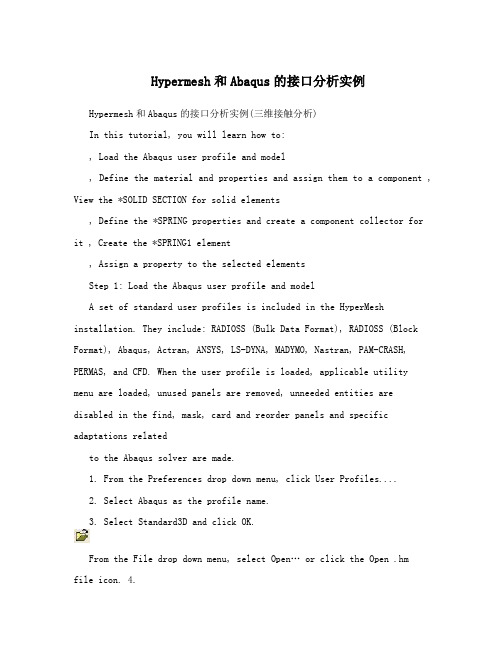
Hypermesh和Abaqus的接口分析实例Hypermesh和Abaqus的接口分析实例(三维接触分析)In this tutorial, you will learn how to:, Load the Abaqus user profile and model, Define the material and properties and assign them to a component , View the *SOLID SECTION for solid elements, Define the *SPRING properties and create a component collector for it , Create the *SPRING1 element, Assign a property to the selected elementsStep 1: Load the Abaqus user profile and modelA set of standard user profiles is included in the HyperMesh installation. They include: RADIOSS (Bulk Data Format), RADIOSS (Block Format), Abaqus, Actran, ANSYS, LS-DYNA, MADYMO, Nastran, PAM-CRASH, PERMAS, and CFD. When the user profile is loaded, applicable utility menu are loaded, unused panels are removed, unneeded entities are disabled in the find, mask, card and reorder panels and specific adaptations relatedto the Abaqus solver are made.1. From the Preferences drop down menu, click User Profiles....2. Select Abaqus as the profile name.3. Select Standard3D and click OK.From the File drop down menu, select Open… or click the Open .hmfile icon. 4.5. Select the abaqus3_0tutorial.hm file.6. Click Open.Step 2: Define the material propertiesHyperMesh supports many different material models for Abaqus. Inthis example, you will create the basic *ELASTIC material model with no temperature variation. The material will then be assigned to the property, which is assigned to a component collector.Follow the steps below to create the *ELASTIC material model card: 1. From the Materials drop down menu, select Create.2. Click mat name = and enter STEEL.3. Click type= and select MATERIAL.4. Click card image = and choose ABAQUS_MATERIAL.5. Click create/edit. The card image for the new material opens.6. In the card image, select Elastic in the option list.By default, the selected type is ISOTROPIC. If not, click the switch and select 7. ISOTROPIC.By default, the ELASTICDATACARDS= field value is 1. If not, input 1to set the 8. number of datalines.9. Click the field beneath E(1) and enter 2.1E5.10.Click the field beneath NU(1) and enter 0.3.11.Click return to accept the changes to the card image.12.Click return to exit the panel.Step 3: Define the *SOLID SECTION properties1. From the drop down menu, select . PropertiesCreate2. Click and enter Solid_Prop. prop name=3. Choose a color for the property.Click on and set it to This ensures that sections pertainingtype=SOLID SECTION.only to solid elements are available as card image options. Alternatively, the4. type = field can be set to ALL ensuring that all available card images are listed.5. Click on card image= and select SOLIDSECTION.6. Click material= and select STEEL.7. Click create.8. Click return to exit the panel.Step 4: Assign the property to the componentBecause the material is assigned to the property, when you assign the property toa component, the material is automatically assigned as well. 1. From the Collectors drop down menu, select Edit and select Components.2. Click the yellow comps button and select INDENTOR and BEAM from the list.3. Click select.4. If necessary, click the toggle to switch <property blank> to property= .5. Double-click property= and select the Solid_Prop.Notice that the card image= and material= are already set from the Solid_Prop property.6. Click update.7. Click return to exit the panel.Step 5: View the *SOLID SECTION for solid elements HyperMesh supports sectional properties for all elements from the property collector.Complete the steps below to view the *SOLID SECTION card for an existing component:1. From the Properties drop down menu, select Card Edit.2. Click props and select Solid_Prop from the list of property collectors.3. Click select to finish the selection process.4. Click edit to view the *SOLID SECTION property card image.5. Click return to finish the viewing process.6. Click return to exit the panel.Step 6: Define the *SPRING propertiesIn Abaqus contact problems, it is common to use weakly grounded springs to providestability to the solution in the first loading step. This section explains how tocreate these springs and how to create the *SPRING card. Complete the steps below to create the *SPRING card: 1. From the Properties drop down menu, select Create.2. Click prop name= and type in Spring_Prop.3. Choose a color for the property collector.Click on type= and set it to LINE SECTION. This ensures that sections pertainingonly to 1D elements are available as card image options. Alternatively, the type4. = field can be set to ALL ensuring that all available card images are listed.5. Click on card image= and select SPRING.6. Click material= and select STEEL.7. Click create/edit.8. In the dof1 field, enter 3.The dof2 field in the *SPRING card is ignored by Abaqus for SPRING1 elements.9. In the Stiffness field, enter 1.0E-5.10. Click return to accept the changes to the card image.11.Click return to exit the panel.Step 7: Create a component collector for the *SPRING property 1. From the drop down menu, select and select . CollectorsCreateComponents2. Click and type in GROUNDED. comp name=3. Choose a color for the property collector.4. If necessary, click the toggle to switch <property blank> to property= .5. Double-click property= and select the Spring_Prop.Notice that the card image = and material = are already set from the Spring_Propproperty.6. Click create.7. Click return to exit the panel.To reset the view for further processing:Click the isometric view icon . 1.Step 8: Create the SPRING1 element1. From the Mesh drop down menu, select Assign and select Element Type.2. In the 1D sub-panel, click mass = and select SPRING1.In HyperMesh, grounded elements are created and stored as mass elements since theyonly have one node in the element connectivity. 3. Click return to exit the panel.On the status bar at the bottom of the window, the name of the current component4. is displayed. Click on that name.5. Select GROUNDED from the list of component collectors that appears.As the spring elements are created, they will be placed in this component.6. From the Mesh drop down menu, select Create and select Masses.7. Click nodes and select by id from the pop-up menu.8. In the id = field, enter 451t460b3 and click Enter on the keyboard.This shorthand selects all of the nodes from 451 to 460 in increments of 3.9. Click create.10.Click return to exit the panel.定义接触面和相互作用Step 9: Start the Contact Manager1. From the Utility menu, click the Contact Manager button.The Abaqus Contact Manager dialog opens. Step 10: Create the "Indentor-top" surface 1. Select the Surface tab in the Abaqus Contact Manager dialog.2. Click the New… button.The Create New Surface dialog opens.3. In the Name: field, enter indentor-top.4. Select Element based as the type of surface.5. Click Color and select a color.6. Click Create….The Element Based Surface dialog opens for defining elements and corresponding faces for the surface.In the Model Browser, expand the Components folder to display all the contents. 7. Right-click on indentor and select Isolate.Click the user views icon and select top. 8.9. In the Element Based Surface dialog, select the Define tab.10.In the Define surface for: list, select 3D solid, gasket.11.Click the Elements button.This opens the element selector panel.12.Click the elems button.13.Select by collector.14.Check the indentor component and click select.You will see the elements in indentor component highlighted.15.Click proceed to return to the Element Based Surface dialog.16.S elect Solid skin option from the Select faces by: radio buttons.17.Select a color from the Solid skin color: button.18.Click the Faces button.This creates a temporary skin of the selected elements and opens the element selector panel.19. Select an element from the top of the solid skin.20.Click the elems button and select by face.You will see all faces at the top of the solid skin are highlighted. 21.Rotate the model in HyperMesh interface to verify all desired facesare selected.You can deselect any element (by right clicking) or add more if you like.When you are satisfied with the element faces selected, clickproceed to return 22.to the Element Based Surface dialog.23.Click the Add button to add these faces to the current sur face.This creates special "face" elements (rectangles with dot in the middle) for display.You can reject the recently added "faces" by clicking the Reject button. You can alsodelete "faces" from the Delete Face page.When satisfied with the surface definition, click Close to return to the Abaqus 24. dialog. Contact ManagerStep 11: Create the "Beam-bot" surfaceSelect the Surface tab in the Abaqus Contact Manager dialog andclick the Display1. None button to undisplay all surfaces.2. Click the New… button.This opens the Create New Surface dialog. 3. In the Name: field, enter cylinder-top.4. Select Element based as the type of surface.5. Click the Color: button and select a color.6. Click Create….The Element Based Surface dialog opens for defining elements and corresponding facesfor the surface.In the Model Browser, expand the Components folder to display all the contents.7. Right-click on Beam and select Isolate.8. In the Element Based Surface dialog, select the Define tab.9. In the Define surface for: list, select 3D solid, gasket.10.Click the Elements button.This opens the element selector panel. 11.Click the elems button, select by collector, check Beam component and click select. This highlights the elements in Beam component. 12.Click proceed to return to the Element Based Surface dialog.13.Select Solid skin from the Select faces by: radio buttons.14.Select a color from the Solid skin color: button.15.Click the Faces button.This creates a temporary skin of the selected elements and opens the element selector panel.16.Select an element from the solid skin, click the elems button, and select by face.You will see faces all around the solid skin are highlighted.Rotate the model in the HyperMesh interface to verify all desired faces are17.selected.You can deselect any element (by right clicking) or add more if you like.When you are satisfied with the element faces selected, click proceed to return 18.to the Element Based Surface dialog.19.Click the Add button to add these faces to the current surface.This creates special "face" elements (rectangles with dot at the middle) for display. You can reject the recently added "faces" by clicking the Reject button. You can also delete "faces" from the Delete Face page.When satisfied with the surface definition, click Close to return to the Abaqus20. dialog. Contact ManagerStep 12: Define the surface interaction propertyIn this exercise, you will define the *SURFACE INTERACTION card with corresponding *FRICTION card.Complete the steps below to create the "friction1" surface interaction: 1. Select the Surface Interaction tab at the Abaqus Contact Manager dialog.2. Click the New… butt on.This opens the Create New Surface Interaction dialog.3. In the Name: field, enter friction1.4. Click the Create… button.The Surface Interaction dialog opens.5. Select the Define tab.6. Select Friction option as surface interaction property.That makes the Friction tab active.7. Select the Friction tab.8. Select the Friction type: as Default and click the Direct option.Selecting this option means that the exponential decay and Anisotropic parameters will not be written to the input file.9. In the No of data lines field, enter 1 and click set.A single row appears in the Direct table.10.Click the first cell on the Friction Coeff column and enter 0.05.For Direct and Anisotropic tables:The column numbers in the table will change with the No of Dependencies selected.The row numbers can be defined at the No of data lines entry box. Clicking thecorresponding Set button will update the table to have the specified number of • rows.For placing values in the table, click a cell to make it active and type in the • values. The table works like a regular spreadsheet.You can also read comma-delimited data from a text file by clicking the Read Froma File button. This button opens up a file browser window. Selectthe file andclick Open to export the comma-delimited data. The row number willbe set to the • number of data lines found in the file.Right-clicking in the table shows a pull down menu with copy, cutand paste options.Comma-separated data can be copied/cut into or pasted from clipboard with theseoptions. Relevant hot keys (for example, Ctrl-c, Ctrl-x and Ctrl-vin Windows) • will also work.Clicking the left mouse button in a cell activates that cell.Clicking into an • already active cell moves the insertion cursor to t he character nearest the mouse.• Moving the mouse while the left mouse button is pressed highlights a selected area.• The left, right, up and down arrows moves the active cell.• Shift-<arrow> extends the selection in that direction.• Ctrl-left arrow and Ctrl –right arrow move the insertion cursor within the cell.• Ctrl -slash selects all the cells.Back space deletes the character before the insertion cursor in the active cell. • If multiple cells are selected, Back space deletes all selected cells.Delete deletes the character after the insertion cursor in theactive cell. If • multiple cells are selected, Delete deletes all selected cells.Ctrl -a moves the insertion cursor to the beginning of the active cell. Ctrl-e • moves the insertion curs or to the end of the active cell.Ctrl –minus (-) and Ctrl –equal (=) decrease and increase thewidth of the column • with the active cell in it.To interactively resize a row or column, move the mouse over the border while • Button-1 or Button-3 (the right button on Windows) is pressed.11.Click OK to return to the Abaqus Contact Manager dialog.Step 13: Create the "Beam-Indentor" contact pair1. Go to the Interface tab of the Abaqus Contact Manager dialog.2. Click the New… button.This opens the Create New Interface dialog.3. In the Name: field, enter Beam-indentor.4. Select Contact pair as the type of interface.5. Click the Create… button.The Contact Pair window opens.6. Select the Define tab.7. Click the Surface: pull down menu to show a list of the existing surfaces.Select indentor from the list and click the Slave>> button toidentify it as the8. slave surface and move it into the table.9. Click the corresponding Review button.The selected surface is highlighted in red. If the surface isdefined with sets (display option disabled), the underlying elements are highlighted. Right-click on Review to clear the highlighting.The corresponding New button opens the Create New Surface dialog for creating a new surface. When you are done creating and defining thesurface, the Contact Pair window returns with the new surface selected as the slave surface.Repeat steps 7 and 8, selecting Beam and clicking the Master>>button to identify10. it as the master surface.Note: To more clearly see the surfaces available for selection,click the icon.This opens an enhanced browser where you can easily search for the appropriate item. You can also click the Filter button to filter the items displayed.Click the Interaction: drop down list to see a list of the existing surface 11.interactions.Note: To more clearly see the interactions available for selection, click the icon. This opens an enhanced browser where you can easily search for the appropriate item. You can also click the Filter button to filter the items displayed.12. Select friction1 from the list as the interaction property for the current contactpair.13.Selec t the Parameter tab.14.Select SmallSliding from the available options.15. Click OK to return to the Abaqus Contact Manager dialog.16 Click close to the Abaqus Contact Manager dialog.创建载荷和边界条件Step 14: Define a *STEP card and specify *STATIC as the analysis procedureIn this exercise, you will create a *STEP card with the *STATIC analysis procedure.1. On the Utility tab, click Step Manager.The Step Manager dialog is displayed.2. Click New…3. In the Name: text box enter step1.4. Click Create to create the step.This creates a step called step1 and opens the Load Step edit dialog.5. From the tree on the left side of the window, select Title.The Step heading: option with a disabled field is displayed. 6. Activate the Step heading: check box and enter 100kN load in the text box.7. Click Update to store the heading information into step1.8. From the tree, select Parameter.Activate the Name and Perturbation check boxes, and click Update. Notice that 9. name is already set to step1.10.From the tree, select Analysis procedure.11.For Analysis type:, select static and click Update.In this exercise, you created a step (*STEP) called step1 andspecified *STATICas the analysis procedure.12.To add a dataline, go to the Dataline tab and enable Optional dataline.To add individual data, such as Initial increment, enable the appropriate fieldand enter a value. If one entry field is not enabled, a space willbe added in 13.the ASCII file, and the Abaqus solver uses the default value.Next, you will define the loads and boundary conditions. Step 15: Create constraints (*BOUNDARY)1. From the tree, select Boundary.2. Click New… and enter loads_and_constraints in the Name: text box.3. Click Create to create the load collector.Optionally, click the button in the Display column and select acolor for the load4. collector.Make sure the Status check box for loads_and_constraints is checked. By selecting5. this check box, you are adding this load collector into the loadstep.6. Click the loads_and_constraints load collector in the table.A set of new tabs is displayed on the right.7. From the Define tab, keep Type: set to default (disp).8. Click the Define from ‘Constraints’ button. panelThis takes you to the Constraints panel in HyperMesh. Use this panel to createconstraints.Step 16: Create constraints from the Constraints panel 1. On the toolbar, click the user views icon and select right.2. Click the yellow nodes button and select by sets.3. select ENDS then Click select buttom.4. Activate dof1, dof2, dof3, unactivate dof4, dof5, dof6.5. Click create.HyperMesh creates constraints at the nodes you selected. 6. Click return.You are returned to the Step Manager Load Step dialog.Look at the Load type: line at the bottom of the Step Manager dialog. Notice thatBc (short for BOUNDARY) appears on this line, identifying it as aload type createdin the load_and_constraints load collector. The corresponding load type on the 7. tree is also highlighted.Step 17: Create Forces (*CLOAD)1. From the tree, double-click Concentrated loads.2. Select CLOAD-Force from the expanded options under Concentrated loads.3. Click New… and enter 100KN_loaded in the Name: text box.4. Click Create to create the load collector.Optionally, click the button in the Display column and select a color for the load5. collector.6. Make sure the Status check box for 100KN_loaded is checked. By selecting this checkbox, you are adding this load collector into the loadstep.7. Click the 100KN_loaded load collector in the table.A new set of tabs is displayed.8. From the Define tab, define CLOAD_Force on: Nodes or geometry.9. From Define tab, click Define from ‘Forces’ Panel.The HyperMesh Forces panel is displayed. Use this panel to create forces.Step 18: Create forces from the Forces panel 1. From the graphics area, click the central node on the front side of the indentor.2. In the magnitude: text box, enter –100 kN.3. Click the switch next to N1, N2, N3 and select Y-axis.4. Click create.5. Click return.You are returned to the Step Manager Load Step dialog.Notice that Cload-f is now added to the Load type: line, indicating CLOAD-forceas another load type created in the loads_and_constraints load collector. The 6. corresponding load types on the tree are also highlighted.7. From the Load Step dialog, left-click Review.The constraints and forces that belong to the loads_and_constraints load collectorare highlighted.8. Right-click Review.The highlighted constraints and forces revert back to the load collector color.Steps 19-20: Define Output Requests(定义输出)In this exercise, you will specify several output requests for step1. There are two methods for defining output request described below. Step 19: Request ODB file outputs1. From the tree, double-click Output request.2. Select ODB file from the expanded options under Output request.3. Click New… and enter step1 output in the Name: text box.4. Click Create.5. Click step1 output (which you just created).A new set of tabs is displayed on the right.6. From the Output tab, activate the Output check box. Leave Output set to field.7. Activate the Node output and Element output options.The Node Output and Element Output tabs are activated. 8. Click the Node Output tab.9. Click Displacement and activate the U check box.U is added to the data line on the right. You are now requesting displacement resultsin the ODB file.Note: You can manually type in an output request into this table, including unsupported requests. They will be written out as entered in the table. 10. Click Update.11.Click the Element Output tab.12.Activa te the Position check box and set it to Nodes.13.Click Stress and activate the S check box.S is added to the data line on the right. You are now requesting stress results inthe ODB file.14.Click Update.Step 20: Request results file (.fil) outputs1. From the tree, under Output request, select Result file (.fil).2. From the Define tab, activate the Node file and Element file check boxes.The Node File and Element File tabs are activated.From the Node File tab, in the lower left area, expand Displacement and activate 3. U.U is added to the data line on the right. You are now requesting displacement resultsin the .fil file.4. Click UpdateFrom the Element File tab, activate the Position check box and set it to averaged 5. at nodes.6. In the lower left area, double-click Stress and activate S.S is added to the data line on the right. You are now requesting stress results in the .fil file.7. Click Update.8. Click Review.A text-editor showing the output requests you made is displayed. This is the format used in the Abaqus input file (.inp).9. Click Close on the text-editor window.10. Click Close.The Load Step edit dialog of Step Manager closes and you are returned to the main Step Manager dialog. The main Step Manager dialog displays step1 information as wedefined in previous exercises.11.Click Close to exit the Step Manager dialog .Steps 21-22: Export the database to an Abaqus input fileThe data currently stored in the database must be output to an Abaqus .inp file for use with the Abaqus solver. The .inp file can then be used to perform the analysis using Abaqus outside of HyperMesh.Step 21: Export the .inp file1. From the File drop down menu, select Export....2. In the File: field, enter job1.inp.3. Click the Export Options down arrows.4. Click the Export: toggle to all.5. Click . Apply6. Click to close the panel. CloseExportStep 22: Save the .hm file and quit HyperMesh1. From the File drop down menu, select Save as….2. Select your working directory and for File name:, enter job1.hm.3. Click Save.4. From the File drop down menu, select Exit.。
hypermesh与ls-dyna接口(推荐看看,可以提高对软件的理解)

hypermesh与ls-dyna接口(推荐看看,可以提高对软件的理解) 1.输出数据控制指定要输入到D3PLOT、D3PART、D3THDT文件中的二进制数据【NEIPH】――写入二进制数据的实体单元额外积分点时间变量的数目。
【NEIPS】――写入二进制数据的壳单元和厚壳单元每个积分点处额外积分点时间变量的数目。
【MAXINT】――写入二进制数据的壳单元积分点数。
如果不是默认值3,则得不到中面的结果。
【STRFLAG】――设为1会输出实体单元、壳单元、厚壳单元的应变张量,用于后处理绘图。
对于壳单元和厚壳单元,会输出最外和最内两个积分点处的张量,对于实体单元,只输出一个应变张量。
【SIGFLG】――壳单元数据是否包括应力张量。
EQ.1:包括(默认) EQ.2:不包括【EPSFLG】――壳单元数据是否包括有效塑性应变。
EQ.1:包括(默认) EQ.2:不包括【RLTFLG】――壳单元数据是否包括合成应力。
EQ.1:包括(默认) EQ.2:不包括【ENGFLG】――壳单元数据是否包括内能和厚度。
EQ.1:包括(默认) EQ.2:不包括【CMPFLG】――实体单元、壳单元和厚壳单元各项异性材料应力应变输出时的局部材料坐标系。
EQ.0:全局坐标 EQ.1:局部坐标【IEVERP】――限制数据在1000state之内。
EQ.0:每个图形文件可以有不止1个state EQ.1:每个图形文件只能有1个state 【BEAMIP】――用于输出的梁单元的积分点数。
【DCOMP】――数据压缩以去除刚体数据。
EQ.1:关闭(默认)。
没有刚体数据压缩。
EQ.2:开启。
激活刚体数据压缩。
EQ.3:关闭。
没有刚体数据压缩,但节点的速度和加速度被去除。
EQ.4:开启。
激活刚体数据压缩,同时节点的速度和加速度被去除。
【SHGE】――输出壳单元沙漏能密度。
EQ.1:关闭(默认)。
不输出沙漏能。
EQ.2:开启。
输出沙漏能。
【STSSZ】――输出壳单元时间步、质量和增加的质量。
- 1、下载文档前请自行甄别文档内容的完整性,平台不提供额外的编辑、内容补充、找答案等附加服务。
- 2、"仅部分预览"的文档,不可在线预览部分如存在完整性等问题,可反馈申请退款(可完整预览的文档不适用该条件!)。
- 3、如文档侵犯您的权益,请联系客服反馈,我们会尽快为您处理(人工客服工作时间:9:00-18:30)。
Hypermesh模板文件的编写-以Flac3D为例
关于软件的介绍:
HyperMesh
高性能、开放式有限单元前后处理器,让您在一个高度交互和可视化的环境下验证及分析多种设计情况。
Flac/Flac3D
FLAC(Fast Lagrangian Analysis of Continua,连续介质快速拉格朗日分析)是由Cundall和美国ITASCA公司开发出的有限差分数值计算程序,主要适用地质和岩土工程的力学分析。
问题:如何用Hypermesh做Flac3D的前处理
【具体过程】
在Hypermesh软件中,提供了丰富的接口程序,同时允许用户根据自己的要求进行编写自己的用户模板文件,然后再hypermesh中按照用户自定义模板文件,输出单元和节点的编号等。
【学习例子】:hypermesh中不同软件的接口文件位于:D:\Altair\hw8.0\templates\feoutput
【如何用】:在hypermesh中选择导出选项,进行如下操作
【模板文件部分内容】
*nodes()
*before()
*string("G ")
*fieldleft(integer,id,16)
*string(" ")
*fieldleft(real,x,16)
……
*fieldright(real,z,16)*end()
*after()
*output()
*elements(204,0,"Tetra4","property")
*before()
*beforecollector()
*string(";;ELEMENTS GROUP = ")
*fieldleft(string,,8) *end() *format()
*string("Z T4 ")
*fieldleft(integer,id,8)
……
*fieldleft(integer,node4.id,32) *end()
*aftercollector()
*after()
*output()
导出的效果:。
